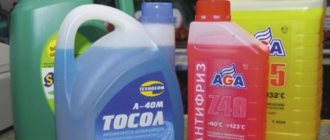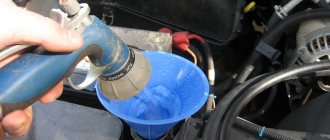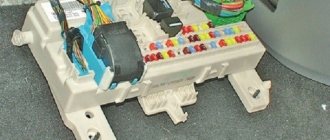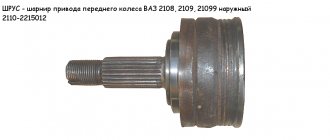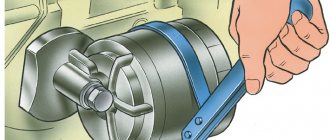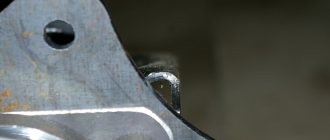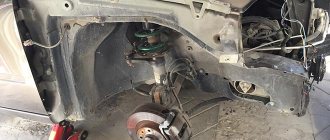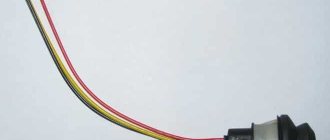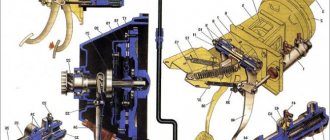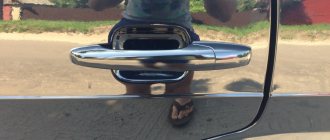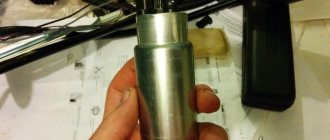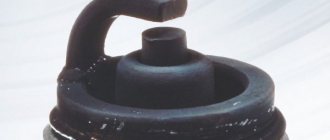How to find out what is in the cooling system of a car
Replacing antifreeze in a Chevrolet Lanos 1.5 is not a complicated procedure, but it is much more difficult to choose the appropriate coolant that will ensure efficient engine operation (meaning, it will ensure quick warming up of the engine in winter and cooling it in summer). Which coolant is best to fill into a car is described in detail in this material. Today we will learn how to determine what kind of coolant is poured into the cooling system of Lanos, Sense and Chance cars, how to determine the need for replacement, and also how to replace antifreeze with your own hands.
If you forgot or bought a car, but did not find out from the previous owner what type of refrigerant he used, then you can find out on your own. Two types of refrigerants are used as coolants - antifreeze and antifreeze. To find out what type of coolant is filled, you need to pay attention to the following factors:
- Resistance to frost - for this it is not necessary to wait for the arrival of cold weather.
Fill the bottle with some liquid from the expansion tank and place it in the freezer. If after 20-30 minutes the coolant does not freeze, then it is high-quality antifreeze. Freezing of the liquid indicates that low-quality antifreeze has been poured into the system. - Color -
antifreeze is painted blue, and coolant has different color options. If there is blue liquid in the tank, then there is a high probability that antifreeze is poured into the system. Few people know, but antifreeze was also produced in red color, and it had a crystallization temperature of -65 degrees. However, such liquids were not available for free sale, but were intended for use in harsh polar conditions. - Use a hydrometer - this is a special device for determining density.
The density of antifreeze ranges from 1.073 to 1.079 g/cm3, and antifreeze has a lower density.
Antifreeze, which was produced back in the 70s under the USSR, differed from modern analogues in its high quality. In addition to its resistance to boiling and crystallization, the antifreeze changed its color as the amount of additives was reduced. When the blue liquid became colorless, it meant it needed to be replaced. The production of high-quality antifreeze continued until the 90s, after which production was curtailed and closed. However, liquids with the name “Antifreeze” continued to be produced, but only at various enterprises in the Russian Federation.
Modern antifreeze manufacturers make it using inorganic compounds and other substances that do not meet standards. This leads to the fact that the liquids work for no more than 2 years, and have a low boiling point (up to 110 degrees). Based on the current historical situation with antifreeze, today many motorists prefer to use foreign analogues, which cannot be called wrong. Using one of the above methods, you can understand what exactly is poured into the Lanos cooling system.
How to change the coolant?
Let's take a closer look at how to replace antifreeze in Lanos with your own hands.
Required Tools
To replace you will need the following tools:
- pliers;
- screwdriver;
- 10mm wrench, it is better to use a socket wrench;
- a bucket or old basin into which the waste liquid will be drained (a cut-off five-liter bottle will do);
- a jack to raise the front of the car;
- a watering can or funnel, with its help you will carefully pour in the new “Antifreeze” (the cut off top of the bottle will also work).
How to drain?
Changing a consumable begins with draining it:
- It will not be possible to completely remove all the antifreeze from the system, but you should try to drain as much fluid as possible from the engine. To do this, the vehicle must be placed on a flat surface; it will be more convenient to drive it into a pit or overpass.
- Find the refrigerant drain plug on the radiator; it is located on the left, in the lower corner, as shown in the photo. Place a prepared container under the plug to collect used antifreeze. Unscrew the lid.
- After this, unscrew the filler cap located on the expansion tank.
- The draining process will begin. To quickly drain consumables from the system, you need to remove the pipe from the fitting located on the throttle. This pipe is removed from the throttle assembly using pliers or a screwdriver.
- You won’t be able to drain all the refrigerant, but you can try to minimize the remainder in the cooling system of the power unit. To do this, take a jack and use it to lift the rear right wheel.
1. Plug for draining antifreeze in the Lanosov radiator 2. Remove the pipe from the fitting for faster draining 3. Clean the expansion tank and flush the cooling system 4. Fill the tank with new coolant
Flushing
If the antifreeze has never been changed before or there are deposits in it, then the system must be flushed.
Otherwise, the dirt that remains in it will not allow the liquid to fully perform its functions. Water is used to flush the cooling system. Buy distilled water; tap water is not recommended. It contains substances and microorganisms that can lead to corrosion on metal elements of the system, for example, a radiator.
- Flushing is performed by tightening the plug on the radiator device with cream. About five liters of distillate are poured into the expansion tank. Water flows until it begins to flow out of the previously disconnected throttle pipe. When this happens, the pipe is put in place and the plug on the expansion tank is tightened.
- Now the car engine starts, it should run for 3-5 minutes.
- After this time, the water is drained from the cooling system. Assess the color and condition of the drained liquid - it will contain sediments and deposits, the color is usually brown. If the drained water is dirty, the washing process is repeated two to three more times. Flushing is done until the water drained from the system is as clean as possible.
- In practice, deposits also form in the cistern. Remove it using a 10mm wrench and rinse the container with clean water.
How to fill coolant correctly?
When draining and flushing are completed, new refrigerant is added. The drain plug is screwed in, the pipe from the throttle is installed in place. When pouring liquid, antifreeze must be added to the maximum mark on the tank body. To speed up this procedure, when filling, you should press the hoses of the radiator device with your hands from time to time. This will avoid the occurrence of air locks in the system. When the filling is completed, the power unit is started for a few minutes, then switched off. This is done to diagnose the refrigerant level in the expansion tank - it should decrease. If this happens, then the liquid is again added almost to the MAX mark.
Below is a detailed video instruction on how to independently replace the refrigerant in Lanos from the Garage TV channel.
How to determine the need to replace the coolant on Lanos
Information on how often you need to change the coolant on your car is very useful. However, it is not always relevant, since few car owners remember when the last replacement was made. To determine whether it is time to change antifreeze on Lanos, Sense and Chance, you need to rely on some methods.
This is interesting!
The service life of the coolant depends not only on the manufacturer’s recommendations, but also on the quality and type of coolant, as well as the material of the radiators used. For comparison, the manufacturer of Lanos, Sense and Chance cars recommends replacing the coolant every 40,000 km or 3-4 years, while Volkswagen gives a lifetime service life.
Today, manufacturers are producing a new generation of antifreeze, the service life of which has been increased to 200 thousand km. This resource is determined by the presence of anti-corrosion additives. It is not rational to buy such an expensive refrigerant for a budget car, so when using antifreeze, it should be changed every 3-4 years.
You can determine the need to replace antifreeze on Lanos by the state of the refrigerant. The liquid must be clean and free of dirt, rust and other deposits. If the condition of the fluid is not satisfactory, it should be replaced and the system flushed. It is recommended to change directly to the type of fluid that was poured into the system from the factory. You can find out the type of fluid in the technical documentation for the car. However, finding a similar brand of refrigerant can be problematic, so we use the most suitable type of coolant.
How often should antifreeze be changed?
According to technical regulations, antifreeze in Chevrolet Lanos cars is replaced at least every 40 thousand kilometers. Or once every four years. During this time, the liquid will lose its properties and will not be able to perform the tasks assigned to it.
Used and new antifreeze for Lanos
How to determine that replacement is required?
Changing and filling the coolant is carried out in the following cases:
- If there is sediment at the bottom of the expansion tank. Looking at the tank, you will see how there is a dense layer of sediment at the bottom. Or all the liquid in the expansion tank may be in the form of a large lump. Often deposits form at sub-zero temperatures. Sediment may appear in the radiator and in the cooling system pipes. But it is visible only in the expansion tank. If there is sediment in the cooling system, replacing consumables is accompanied by a complete flushing of the radiator, tank and lines.
- If the freezing point of antifreeze has increased. To check, you can use a special device - a hydrometer. You can find the device in any automobile store. If the properties of the coolant have changed, the consumable must be replaced. Antifreeze density is checked in accordance with the technical table, which can be found in the service manual for the car. If you don't have a hydrometer, you can do without it. When the ambient temperature drops to -15 degrees, carefully unscrew the cap on the expansion tank. If there is a yellowish coating on the surface of the liquid, then the consumable material has begun to thicken. In the future, this will lead to its rapid freezing. Then the refrigerant must be replaced.
- The main symptom is that the consumable material loses its natural color. It becomes brown, with a hint of rust. In this case, the refrigerant reacts with the metal components of the radiator device and can lead to their destruction. As a result, the radiator will fail. When the refrigerant becomes discolored, it cannot perform its intended functions. Because of this, the engine overheats. Then the refrigerant needs to be changed.
- The liquid turned into a cotton-like state. This can be seen in the summer heat. The appearance of flakes in the liquid indicates the need to replace it.
- Formation of foam on the surface of the antifreeze in the expansion tank. When the refrigerant foams, it means it needs to be replaced. If you ignore the appearance of foam, the power unit will overheat.
- Indirect signs include inefficient operation of the stove. As a result of the fact that the coolant cannot perform primary functions, the heater operates less efficiently. This is especially felt in the winter season.
The brown color of antifreeze indicates its ineffectiveness.
How much antifreeze does the cooling system of Chevrolet and Daewoo Lanos hold?
Before you replace the coolant with Lanos 1.5, you will need to initially purchase the required amount of refrigerant. For each car model, the amount of coolant is different. The required amount of antifreeze is indicated directly in the technical documentation for the car.
The capacity of the cooling system for Lanos, Sense and Chance is 7 liters. This is exactly the amount of coolant that will need to be purchased in advance before replacing it. However, during the replacement process, you may encounter the fact that some of the liquid being poured will remain - approximately 1.5-2 liters. This is due to the fact that it is almost impossible to drain all the liquid from the system. That is why 5 liters of new antifreeze (3.5 liter concentrate) is enough, poured into the engine cooling system of Chevrolet, Daewoo and ZAZ Lanos.
Leaks and problems
Problems with the cooling system in Lanos are typical for most cars. From time to time it is necessary to change the thermostat and pump. Sometimes, over time, the expansion tank begins to leak.
Antifreeze leaks from the pipes occur due to their wear, as well as due to failed clamps. Leaks can also occur from excess pressure in the system, due to the failure of the bypass valve located in the expansion tank plug. Therefore, it is recommended to change the cover periodically.
What antifreeze to pour into the engine cooling system of Lanos, Sens and Chance
Today there are a large number of types of coolants on the market. Which type of coolant is best to choose depends on many factors. To decide which antifreeze to pour into the Lanos engine cooling system, you should familiarize yourself with this material, on the basis of which you can make the right decision.
Experts recommend pouring antifreeze into Lanos of the same brand that was originally filled from the factory. In this case, you won’t even need to flush the system first. If a different brand of antifreeze is selected (in most cases), then a system flushing procedure is carried out before replacement.
Changing engine oil in Daewoo Lanos, Daewoo Nexia, Chevrolet Lanos
I have free time and a strong desire to write fresh material for my favorite blog))). About something simple, well-known and in demand... And so, having looked at the already published material in the “ Daewoo ” section, I noticed that there are still no articles on changing the oil in the engine of your favorite Lanos and Nexias. This is not order! I had to, as a matter of priority, correct such an annoying mistake in my work. Therefore, meet, read, evaluate and, if possible, comment on the article describing changing the engine oil of Daewoo Lanos, Daewoo Nexia, Chevrolet Lanos . And, perhaps, we can start with a reminder about the frequency of changing the engine oil. The maintenance regulations for these vehicles recommend changing the engine oil every 10,000 km or after 1 year of operation (whichever comes first). This is clear. We can only add that when using cheap brands of motor oil and/or operating the car in difficult conditions (taxi, frequent starting of a cold engine, driving short distances on a cold engine), it is better to change the engine oil a little earlier than scheduled. For example, after 8,000 - 9,000 km. It’s easier for the engine, and it’s calmer for you... After all, it’s no secret that the service life of the heart of your steel friend, assistant, and companion directly depends on the quality of the engine oil and its condition.
Spare parts. Briefly: engine oil, oil filter (a mandatory purchase, without which there is no need to change the oil) and a new sealing washer-gasket for the engine sump (crankcase) drain plug . Now in more detail. It is recommended to fill the engine of Daewoo Lanos, Daewoo Nexia, Chevrolet Lanos with engine oil of API quality: SJ, SF, SG, SH and viscosity SAE 5W30, 5W40, 10W40, 15W40. Well, 15W40 is already an extreme measure or the limit of savings. The required volume is 3.8 liters . Regarding manufacturers, as always, I advise you to stick to well-known brands: Shell, ADDINOL, ARAL, Elf, etc. Oil filter . Everything is simple here, I list the filters that I trust and use in practice: MANN and MAHLE (Knecht), if everything is not simple in a financial matter, then you can choose filters from Hexen and SCT (of course you won’t save much, but people’s life situations there are all kinds). And finally, about the gasket of the pallet plug. If you forget about this little detail at every oil change, then after 2 or 3 changes, you will be surprised to find small fogging, drops of oil near the pan plug. Not fatal, of course, but such a problem does not bring joy either. Therefore, when purchasing engine oil and an oil filter, we try not to forget about such a little thing as the sump (crankcase) plug gasket. In the automotive markets, they are presented in two versions: copper and aluminum (photo 1). I prefer copper ones.
Tools and place of work. We carry out oil change work on an inspection pit, overpass or lift. The following tools should be with you: a socket or socket wrench for 17 and 19, a container for draining old oil (with a volume of at least 5 liters), a special wrench for unscrewing the oil filter (the simplest, cheapest and most importantly effective wrench for dealing with “stubborn” oil filters). filters - sickle, photo 2), if you don’t have a special key, you should have a screwdriver ready (if you can’t unscrew the filter by hand, then a screwdriver should help, but this will be discussed below), a couple of clean rags and a funnel for comfortable and neat pouring of new oil .
Now, it's time to take action and get your hands a little dirty. Description of changing the oil in the engine of a Daewoo Lanos, Daewoo Nexia, Chevrolet Lanos :
1. If the engine is “cold”, then you should warm it up to operating temperature (80-90 degrees). Of course, you can drain the oil “cold”. But that would be wrong. It’s better to warm up the engine and the oil will drain better and drain faster. And all the slags and combustion products that are deposited on the walls of the engine block are more likely to end up (drain, slide) into the engine sump, and from there into the “waste” drain tank. Therefore, as a result, we drain the oil only from a fully warmed-up engine.
2. Have you warmed it up? We drive the car into the inspection hole. We remove the engine compartment protection from below. Of course, if only it is installed on your car))). Yes, I know that some specialists will say that this is extra work (removing the protection), but we can do it that way. I don't argue, it's possible. But, I still take pictures and advise you. Because this way changing the oil is cleaner, more convenient and safer.
3. Find the drain plug on the engine sump (crankcase) and, using a 19 wrench (on aluminum pallets 17), tear the plug out of place (photo 3). In most cases the key is no longer needed. Unscrew the plug by hand. But we do it carefully and slowly. Since there is a high probability of getting burned. We will still drain the hot oil! To ensure that your hands remain intact, we proceed as follows: With one hand we hold the container for draining the waste, with the other we slowly unscrew the plug. We turn it until it starts to wobble a little and oil starts leaking from under it. Press the plug onto the pan. We twist the plug one last half turn and sharply move the hand (with the plug) to the side. We check that the oil gets exactly into the previously prepared container))).
4. While the oil is draining, which is about 5-10 minutes, you can work on the oil filter. On 8 valve and 16 valve engines of Daewoo Lanos, Daewoo Nexia, Chevrolet Lanos cars, the oil filter is located on the front of the block, under the exhaust manifold (photo 4 top view). On an eight-valve engine, the oil filter can be accessed from above, but unscrewing the filter on a sixteen-valve engine in the same way will be very difficult. Again, it is better to remove the engine protection))). If you have a special key, put it on the filter and unscrew it (photo 5). If there is no key, we try to unscrew the filter by hand, after wrapping it in a rag (it is still hot) or sandpaper. Well, how did things go?? If the oil filter was tightened by “serious” guys before you, and even with both hands, then you are unlikely to be able to tear it out of place with your hand. But there is no key, right? Now, it's time to pick up a hammer and a large screwdriver. We hammer in the screwdriver as shown in photo 6. Nice to see))). And, using the handle of a screwdriver as a lever, we rip the filter out of place. Next, take out the screwdriver and twist it by hand. I understand that it’s a bit dirty, but what can you do, there’s no special key))). We wipe the oil filter seat from dirt, sand and old oil (photo 7).
5. Before installing the new filter, fill it with oil and lubricate the rubber gasket (photos 8 and 9). We tighten the filter by hand. We twist the filter until the rubber gasket comes into contact with the block, then tighten the filter another 3/4 turn. Ready. We tighten the pan plug. First, replace the sealing gasket on the plug. We tighten the sump (crankcase) plug with a force of 45-55 N*m.
6. That's it, we've finished from below. Unscrew the oil filler cap on the valve cover. We take out the dipstick and wipe it. We insert a funnel into the neck of the valve cover and pour 3.8 liters of new oil into the engine. Insert the dipstick and screw on the cap. Let's start the engine. Make sure that the oil pressure warning light (photo 10) goes out within the first 5 seconds. Let the engine run for 30-40 seconds. We're jamming it. We wait a little while the oil drains into the pan. And we carry out a control check of the oil level. Ideally, the oil level on the dipstick should be slightly below (2-4 mm) the “MAX” mark (photo 11).
Look like that's it. The engine oil change for . It remains to check whether there are any oil leaks from under the oil filter and the drain plug of the engine sump (crankcase). If necessary, tighten the tightening a little. And, of course, don’t forget to replace the engine compartment protection. AND…. Mission accomplished.
When using an article or photographs, an active direct hyperlink to the website www.avtorem.info is required!
Did you like the article? Share it on your page!
What is needed to replace antifreeze on Chevrolet and Daewoo Lanos
Before carrying out work on replacing antifreeze and antifreeze on Lanos, you should make sure that you have the necessary tools. The replacement procedure is not difficult, and there is no need to go to a car service center to carry out the replacement. Even a beginner can cope with this task by first preparing the necessary equipment, materials and tools. To replace the refrigerant on Lanos, you should make sure you have the following tools:
- Set of keys and screwdrivers
- Pliers
- Jack
- A container for draining old fluid of at least 5 liters. Draining refrigerant into the ground is strictly prohibited, as this is harmful to the environment. After draining the liquid into the container, it should be disposed of. Antifreeze contains ethylene glycol, which contributes to the development of cancer.
The materials you will need are antifreeze or antifreeze in the required quantity. If the antifreeze is not diluted, then distilled water is purchased separately. To flush the system, you will need a can of special liquid (reagent), which is poured into the system, mixed with the old refrigerant.
Considering the fact that 1.5-2 liters of water remains in the system after draining, which is due to the design of the engine system, when using concentrate you will need to dilute it in the following amount:
- Mix 3.5 liters of concentrate with 1.5 liters of distilled water
- You cannot use ordinary water to dilute the concentrate, as it freezes at subzero temperatures.
When all the preparatory work has been completed, all that remains is to begin the relevant replacement work. First, let's look at how to flush the engine cooling system on Lanos.
Replacement process
Replacing antifreeze in a Chevrolet Lanos can be done with your own hands. To do this, you need to figure out what tools are needed for replacement, how to drain the antifreeze, flush the system and fill in new fluid.
Necessary tools and preparation for replacement
To begin the process of replacing antifreeze for Chevrolet Lanos, you should prepare the following tools:
- Screwdriver;
- Pliers;
- 10mm wrench (preferably use a socket wrench);
- An empty container of sufficient size (basin or bucket) for draining waste liquid;
- Jack to raise the front of the vehicle;
- Watering can or funnel (for filling in new coolant).
How to drain antifreeze from a Chevrolet Lanos?
How to drain antifreeze from Lanos? To do this, you must follow the instructions:
- Place the car on a flat surface. The best option is to drive onto an overpass or pit;
- Find the drain plug on the radiator. It is located in the lower right corner, then unscrew it, having previously placed a container underneath, previously prepared for waste coolant;
- Unscrew the fluid filler cap. It is located on the antifreeze expansion tank. The process of draining the liquid has begun. To speed up this process, you can dismantle the pipe located on the throttle valve. To do this, you can use a screwdriver or pliers;
- It will not be possible to drain all the liquid, so you can try to empty the system as much as possible. To do this, use a jack to lift the rear right wheel.
How to pre-flush a car's cooling system
Before replacing antifreeze on Lanos, Sense and Chance, it is necessary to flush the system. This procedure is not at all mandatory, but it is recommended in the following situations:
- When the type of coolant changes, for example, if antifreeze has been added and it is planned to use antifreeze
- When changing the type of refrigerant, for example, if G11 antifreeze was previously filled, and it is planned to use G12 or G13
- If the refrigerant being drained is red in color and shows signs of blockages
The primary rinsing process involves performing the following manipulations:
- For flushing, a special liquid is used - a reagent, which is poured into the expansion barrel. Before adding flushing fluid, you need to warm up the engine to operating temperature.
- Add fluid and let the engine idle for at least 10-20 minutes.
- In this case, you should turn on the heater in the car to maximum in order to flush the heater radiator
After the engine has been running for 10-15 minutes, you can turn it off and begin draining and replacing the refrigerant. How to replace antifreeze on Chevrolet and Daewoo Lanos, we will consider in detail below.
This is interesting!
Some recommend flushing the system with reagents with ordinary or distilled water, which is poured into the system after draining the coolant. However, reagent manufacturers recommend mixing the composition with antifreeze or antifreeze, which improves flushing properties.
How to fill
- After all previous operations have been completed, pour new coolant into the tank until its level reaches the MAX mark on the expansion tank. We start the engine and wait for the fan to work.
- To better fill the system with liquid and to prevent air locks from forming, be sure to squeeze the radiator pipes with your hands while filling.
- Turn off the engine. Check the antifreeze level in the tank.
- If necessary, add coolant until it reaches the “MAX” mark.
